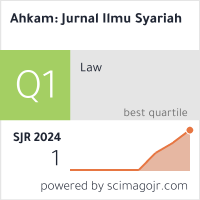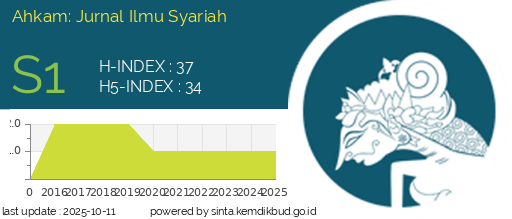The Silent Tarekat in Islamic Law: Legal Consciousness and the Chishti Sufi Legacy of the Tablighi Jamaat
DOI:
https://doi.org/10.15408/ajis.v25i1.44979Keywords:
Tablighi Jamaat, Islamic Law, Sufi Order, Modern Expression, Discursive TraditionAbstract
This article explores the silent legal and spiritual framework of the Tablighi Jamaat (TJ) in Indonesia, drawing on fieldwork, interviews, and textual analysis. While TJ does not claim to be a Sufi order (ṭarīqah), its practices suggest a reconfiguration of the Chishti-Ḥanafī legacy within a non-institutional framework. The study argues that TJ operates as a "silent tarekat", where fiqh is embodied through routines of taʿlīm, khurūj, and adab, rather than articulated through fatwā or formal legal discourse. The article traces how collective reasoning (mushāwarah), ethical discipline, and ritual repetition form an alternative legal consciousness that resists codification but remains deeply normative. Drawing from Talal Asad's theory of discursive tradition and Ibn' Arabi's notion of 'ilm al-aḥwāl, the paper shows how authority, legality, and spirituality are distributed through embodied discipline rather than textual claims. Contrasting with mainstream Islamic institutions in Indonesia like NU, Muhammadiyah, and MUI, which rely on fatwā issuance and formal jurisprudence, TJ emphasizes humility, action, and affective cohesion. The article concludes that TJ represents a post-ṭarīqah legal formation, silent, affective, and decentralized, redefining Islamic normativity through practice rather than proclamation.
Abstrak
Artikel ini menelusuri kerangka hukum dan spiritual Jamaah Tabligh (JT) di Indonesia yang bersifat diam-diam namun terstruktur, berdasarkan observasi lapangan, wawancara, dan kajian teks. Meskipun Jamaah Tabligh tidak mengklaim diri sebagai tarekat, namun praktiknya menunjukkan konfigurasi ulang warisan Chishti-Ḥanafī dalam bentuk non-institusional. Artikel membawa argumentasi bahwa JT berfungsi sebagai “silent tarekat,” yang mana hukum Islam (fiqh) diwujudkan melalui rutinitas ta’līm, khurūj, dan adab, bukan melalui fatwa atau diskursus hukum formal. Artikel ini mencoba melacak bagaimana musawarah, disiplin etis, dan pengulangan ritual membentuk kesadaran hukum alternatif yang tidak tersusun secara kodifikasi, namun tetap normatif. Mengacu pada teori tradisi diskursif Talal Asad dan konsep ‘ilm al-aḥwāl dari Ibn ʿArabi, tulisan ini menunjukkan bahwa otoritas, legalitas, dan spiritualitas dalam JT tersebar melalui disiplin tubuh, bukan klaim tekstual. Berbeda dengan arus utama lembaga Islam di Indonesia seperti NU, Muhammadiyah, dan MUI yang bergantung pada fatwa dan fikih formal, Jamaah Tabligh menekankan kerendahan hati, amal, dan kohesi afektif. Artikel ini menyimpulkan bahwa Jamaah Tabligh merepresentasikan formasi hukum pasca-tarekat—diam, afektif, dan terdesentralisasi—yang menata ulang normativitas Islam melalui praktik, bukan pernyataan.
References
Achmad. (2021). DINAMIKA INTERNAL JAMA’AH TABLIGH DI INDONESIA PASCA SKISMA [Doctoral Thesis, UIN Sunan Kalijaga]. http://digilib.uin-suka.ac.id/id/eprint/51142
Ali, J. (2003). Islamic Revivalism: The Case of the Tablighi Jamaat. Journal of Muslim Minority Affairs, 23(1), 173–181. https://doi.org/10.1080/13602000305935
Al-Kandahlawi, M. Z. (n.d.). The Mashaikh of Chist The Spiritual Tree (Shajarah) and Life Episodes of The Noble Auliya and Mashaikh of Chist (Majlisul Ulema of South Africa, Trans.). Majlisul Ulema of South Africa.
Al-Kandahlawi, M. Z. (2006). Fadhilah Amal (A. Abdurrahman, Trans.). Ash-Shaff.
Anshori, A. Y., & Abdurrahman, L. T. (2024). Constitutional Contestation of the Islamic State Concept in the Indonesian Parliament 1956-1959. De Jure: Jurnal Hukum Dan Syar’iah, 16(2), 278–316. https://doi.org/10.18860/j-fsh.v16i2.29572
Antjum, T. (2006). Sufism in History and its Relationship with Power. Islamic Studies, Islamic Research Institute, 45(2), 221–268.
Arifin, Z. (2017). ISLAM DI TEMBORO Model Kepemimpinan dan Strategi Kebudayaan Jamaah Tabligh dalam Pembentukkan Karakter. UIN Suka Press.
Asad, T. (2009). The Idea of an Anthropology of Islam. Qui Parle, 17(2), 1–30.
Black, A. (2002). The history of Islamic political thought: From the Prophet to the present. Routledge.
Bustamam-Ahmad, K. (2008). The History of Jama‘ah Tabligh in Southeast Asia: The Role of Islamic Sufism in Islamic Revival. Al-Jami’ah: Journal of Islamic Studies, 46(2), 353–400. https://doi.org/10.14421/ajis.2008.462.353-400
Dickson, W. R. (2022). Sufism and Shari‘a: Contextualizing Contemporary Sufi Expressions. Religions, 13(5), 449. https://doi.org/10.3390/rel13050449
Gaborieau, M. (2006). What Is Left of Sufism in Tablîghî Jamâ’at? Archives de Sciences Sociales Des Religions, 51e Année, 135, 53–72.
Göktaş, Prof. Dr. V., Hasan, M. M., Chowdury, S. R. H., & İsmailoğlu, M. (2022a). Spirituality in the Context of Tablighi Jamaat and its Implication on Muslim Society: The Sufi Perspective. International Journal of Social, Political and Economic Research, 9(1), 49–66. https://doi.org/10.46291/IJOSPERvol9iss1pp49-66
Göktaş, Prof. Dr. V., Hasan, M. M., Chowdury, S. R. H., & İsmailoğlu, M. (2022b). Spirituality in the Context of Tablighi Jamaat and its Implication on Muslim Society: The Sufi Perspective. International Journal of Social, Political and Economic Research, 9(1), 49–66. https://doi.org/10.46291/IJOSPERvol9iss1pp49-66
Howell, J. D. (2001). Sufism and The Indonesian Islamic Revival. The Journal of Asian Studies, 60(3), 701–729. https://doi.org/10.2307/2700107
Ilyas, M. A. (2022). The Influence of Tariqa in the Tablighi Jamaat Congregation: Principles and Practices. Jurnal Ilmiah Syi’ar, 22(1), 32. https://doi.org/10.29300/syr.v22i1.5814
Jha, G. K. (2022). Congregation of Tablighi Jama’at During the Pandemic COVID-19 and Its Agenda in India and Indonesia. International Studies, 59(1), 76–96. https://doi.org/10.1177/00208817221093157
Kamran, T., & Shahid, A. K. (2014). Shari‘a, Shi‘as and Chishtiya Revivalism: Contextualising the Growth of Sectarianism in the Tradition of the Sialvi Saints of the Punjab. Journal of the Royal Asiatic Society, 24(3), 477–492. https://doi.org/10.1017/S1356186314000194
Kassam, Z. R., Greenberg, Y. K., & Bagli, J. (Eds.). (2018). Islam, Judaism, and Zoroastrianism. Springer Netherlands. https://doi.org/10.1007/978-94-024-1267-3
Kustiawan, M. T., Rasidin, Mhd., Witro, D., Busni, D., & Jalaluddin, M. L. (2023). ISLAMIC LEADERSHIP CONTESTATION: EXPLORING THE PRACTICES OF CONSERVATIVE ISLAMIC MOVEMENTS IN INDONESIA. Jurnal Ilmiah Islam Futura, 23(2), 196. https://doi.org/10.22373/jiif.v23i2.14938
Mahdi, M. F., & Anshori, A. Y. (2022). The Legal Politics of the Aceh Governor’s Policy Regarding Religious Activities in Public Sphere: David Easton’s Political Theory perspective. Asy-Syir’ah: Jurnal Ilmu Syari’ah Dan Hukum, 55(2), 1. https://doi.org/10.14421/ajish.v56i1.1105
Masud, M. K. (Ed.). (2000). Travellers in Faith: Studies of The Tablīghī Jamāʻat as A Transnational Islamic Movement for Faith renewal. Brill.
Masyhuri, A. (2014). Ensiklopedi 22 Aliran Tarekat dalam Tasawuf (2nd ed.). IMTIYAZ.
Maulana, D. F., Rozak, A., & Mursyid, A. Y. (2023). The Paradigm of Islamic Legal Sociology Towards Counterfeit Books Transactions in The Yogyakarta. Az-Zarqa’: Jurnal Hukum Bisnis Islam, 14(2), 285–307. https://doi.org/10.14421/azzarqa.v14i2.2895
Metcalf, B. (2003). Travelers’ Tales in the Tablighi Jamaʿat. The Annals of the American Academy of Political and Social Science, 588, 136–148.
MUGHNI, S. A., FIRDAUSI, A., & AKMALIYAH. (2019). Dar al-Ulum of Deoband: An Education, Propagation, and Islamic Political Movement in India. Tawarikh Journal of Historical Studies, 10(2), 87–102. https://doi.org/10.2121/tawarikh.v10i2.1136
Musaffa, M. U. A., & Abdurrahman, L. T. (2023). FIKIH PAKAIAN JAMAAH TABLIGH: ANTARA DOKTRIN, IDENTITAS, DAN STRATEGI. Harmoni, 22(1), 48–69. https://doi.org/doi.org/10.32488/harmoni.v1i22.642
Musaffa, M. U. A., Dakum, D., Nurrohim, A. H., & Sudrajad, M. R. (2022). Study the Philosophy of Islamic Law in Determination Percentage of Zakat Mal. Az-Zarqa’: Jurnal Hukum Bisnis Islam, 14(1), 19. https://doi.org/10.14421/azzarqa.v14i1.2589
Nadwi, A. H. A. (1978). The Life and Mission of Maulana Mohammad Ilyas. AhleSunnah Library.
Nasri, A. A., & Dehani, D. (2018). The Recourse to the look Ashraf Ali Tahanavi and Khalil Ahmd Saharnpoory. Journal of Subcontinent Researches, 10(35), 215–228. https://doi.org/10.22111/jsr.2018.4624
Noor, F. A. (2012). Islam on The Move: The Tablighi Jama’at in Southeast Asia. Amsterdam University Press.
Numani, M. M. (1950). Malfoozat Discourses of Maulana Ilyas. Madrasa Arabia Islamia.
Pieri, Z. (2021). Tablīghī Jamāʿat. In M. A. Upal & C. M. Cusack (Eds.), Handbook of Islamic Sects and Movements.
Rizvi, S. M. (1981). The History of Dar al-Ulum Deoband (M. H. F. Quraishi, Trans.; 1st ed., Vol. 2). Idara-e Ihtemam.
Sikand, Y. (2007). THE REFORMIST SUFISM OF THE TABLIGHI JAMA`AT: THE CASE OF THE MEOS OF MEWAT, INDIA. In Sufism and The Modern in Islam. I.B. Taurus.
Sudarman, H. A. (2022, July 22). Wawancara dengan dewan syura wilayah Indonesia [Wawancara langsung].
Usmanov, I. (2023). SUFISM AND FIQH: DIFFERENT VIEWS ON ISLAMIC LAW. Russia and the Moslem World, 4, 117–126. https://doi.org/10.31249/rmw/2023.04.10
Zamhari, A. (2010). Rituals of Islamic Spirituality: A Study of Majlis Dhikr Groups in East Java (1st ed.). ANU Press. https://doi.org/10.22459/RIS.07.2010
Downloads
Published
Issue
Section
License
Copyright (c) 2025 Ahmad Yani Anshori, Landy Trisna Abdurrahman, Moh. Tamtowi, Muhamad Ulul Albab Musaffa

This work is licensed under a Creative Commons Attribution-ShareAlike 4.0 International License.






